Fall webworm (Hyphantria cunea) belongs to the family Arctiidae and is an important international quarantine pest, native to North America and now widely distributed in Eurasia. Fall webworm has a strong reproductive capacity, reproducing two to three generations a year, the first in April and May, the second in June and July, and the third in August and September. A single female moth can lay 800-2,000 eggs per generation, reproducing an average of 30 million offspring per year, up to 200 million, posing a great threat to the agricultural and forestry economies and ecosystems of various countries.
 Figure 1. Larvae (left) and adults (right) of Fall webworm.
Figure 1. Larvae (left) and adults (right) of Fall webworm.
However, the inescapable reality is that for a long time, the massive use of chemical pesticides to control fall webworm-caused pests and diseases has led to serious problems such as environmental pollution, ecological crisis, and health hazards. And there is still little research on natural enemy control (biological control) of the fall webworm, and the control strategies currently used are ineffective, so more means of control are urgently needed.
Insect population genetic manipulation technology is ideal as a new generation of pest control technology because of its species specificity and environmental friendliness. Therefore, the genetic manipulation technology system established by Lifeasible is of great significance to the gene function research and pest control of fall webworms.
CRISPR/Cas9-mediated gene editing technology services
CRISPR/Cas9 system, as an emerging genome editing tool, consists of sgRNA and Cas9 protein. sgRNA can specifically recognize gene sequences and guide Cas protein to perform targeted cleavage of DNA double-strand of target genes. With the help of CRISPR/Cas9-mediated gene-editing technology, Lifeasible has constructed a high-quality platform for efficient genome editing of fall webworm and population genetic control strains for better fall webworm control.
The Yellow gene was reported to play an important role in insect behavior and coloration, and its coloration function is relatively conserved among lepidopteran insects, and the mutant phenotype is easy to observe.
HcWnt-1 knockout affects somatic segmentation and appendage formation in fall webworm, and this gene is essential for the embryonic development of fall webworm. the HcWnt-1 mutation causes embryonic death in fall webworm and could be a target gene for future genetic control of fall webworm.
As one of the serine protease family, the function of the ser2 gene has been rarely reported. However, its family protein serine proteases are the most common proteins in SFP (seminal fluid protein) and are required for post-mating reproductive processes in some insects, showing good promise for the genetic control of pests.
Sex determination is a fundamental life process of organisms, which plays an important role in reproduction, reproduction, evolution, and species diversity. The Dsx gene is not only a functional exploration of the sex determination pathway but also an important target gene for genetic regulation of insect populations as its sex-specific knockout can produce sex-specific sterile phenotypes.

Lifeasible has established the fall webworm embryo microinjection platform and CRISPR/Cas9-mediated gene knockout technology system. We have established the fall webworm embryo microinjection platform with a stable hatching rate by the embryo microinjection method. Through this microinjection platform, we established an efficient fall webworm CRISPR/Cas9 knockout system and obtained phenotypically clear and stable knockout mutants of Hcyellow, HcWnt-1, Hcser2, Hcdsx, and other genes. If you have any questions or any inquiry requirements, please contact Lifeasible.
Reference:
Lifeasible has established a one-stop service platform for plants. In addition to obtaining customized solutions for plant genetic engineering, customers can also conduct follow-up analysis and research on plants through our analysis platform. The analytical services we provide include but are not limited to the following:
STU-CRISPR System Improves Plant Genome Editing Efficiency
April 19, 2024
Application of Exosomes in Facial Beauty
April 12, 2024